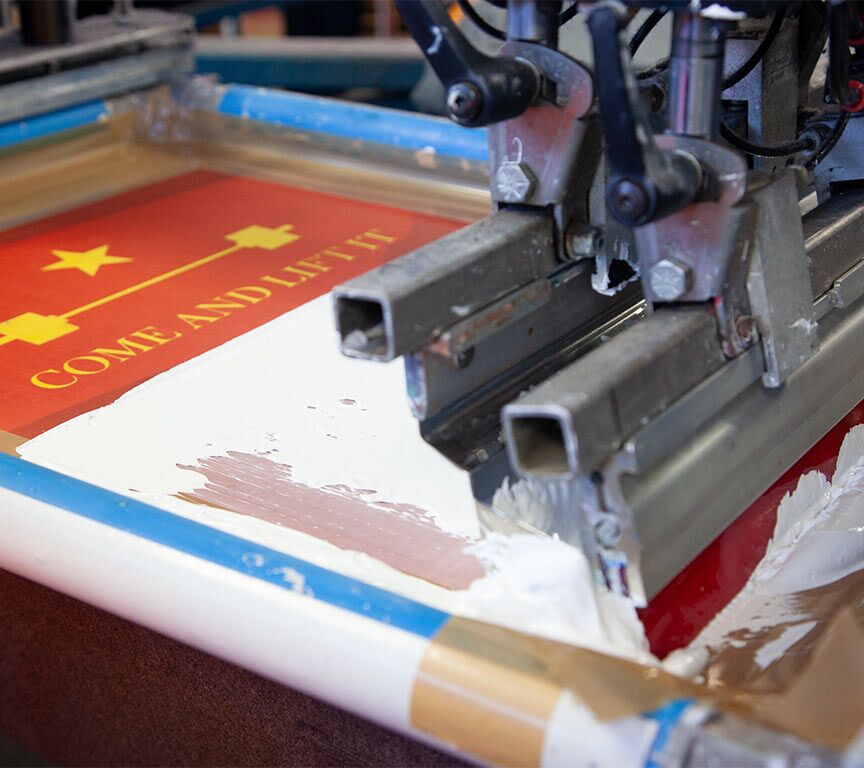Creative T-Shirt Printing Ideas for Small Brands
Creative T-Shirt Printing Ideas for Small Brands
Blog Article
Display Printing Uncovered: Every Little Thing You Required to Understand About Tee and Garment Printing Strategies
If you've ever before asked yourself how those vivid styles end up on your favored tees, you're in the best place. Display printing is a remarkable approach that integrates art with method, providing countless possibilities for creative thinking. Understanding the fundamentals, from equipment to ink options, can significantly impact your outcomes. All set to discover the important elements that make display publishing an art form? Let's uncover the information that can elevate your projects.
The Fundamentals of Screen Printing: How It Works
When you plunge into display printing, you'll uncover it's both a scientific research and an art. At its core, display printing entails developing a stencil, or display, that allows ink to pass via only in specific areas.
Following, you'll blend your inks and prepare your printing surface. Placement the screen over the fabric, after that make use of a squeegee to press ink with the display onto the garment. This process calls for accuracy, as you want clear, dynamic prints. After printing, you'll cure the ink with heat, ensuring it sticks to the fabric and lasts via cleans. Each action is vital, and grasping them will boost your screen printing skills, changing straightforward garments right into unique, expressive pieces.
Kinds of Screen Printing Strategies
When you realize the basics of display printing, it's time to explore the various methods that can boost your designs. One popular approach is conventional screen printing, where ink is pressed via a stenciled screen.
If you're intending for fine details, think about discharge printing. This method gets rid of dye from the material, leaving a soft, vintage look. An additional choice is plastisol printing, known for its resilience and vibrant shades, making it a favored for lots of brands. Finally, explore halftone printing to develop gradient effects and intricate layouts. Each strategy has its unique beauty, so don't be reluctant to attempt them bent on locate what suits your design best!
Vital Devices for Display Printing
To accomplish magnificent results in display printing, having the right devices is essential. You'll require a sturdy screen printing frame, which holds the mesh that transfers your style onto the garment. Next, spend in high-quality squeegees; these are crucial for using ink uniformly across the screen.
Choosing the Right Inks and Materials
When selecting inks and materials for display printing, you need to take right into account the sort of ink that works ideal for your project. Consider material compatibility to assure your designs look excellent and last lengthy. Check out green ink options to make your printing procedure more lasting.
Types of Display Inks
Choosing the right screen ink is vital for achieving lively, durable prints that meet your job's demands. There are a number of types of display inks to check out. Plastisol ink is prominent for its adaptability and convenience of usage, supplying exceptional shade opacity on dark fabrics. Water-based ink, on the other hand, offers a softer feeling and is eco-friendly, making it ideal for those seeking to minimize their ecological influence. Release inks get rid of color from the material, causing a soft, classic look yet call for certain handling. Lastly, specialized inks, such as metal or glow-in-the-dark, can include special results to your layouts. Examine your job requirements and select the ink that straightens finest with your desired outcome.

Fabric Compatibility Factors To Consider
Comprehending fabric compatibility is vital for achieving top quality screen prints, particularly considering that various products respond uniquely to different inks. Constantly test your inks on example fabric to ensure they adhere appropriately and preserve shade stability. Furthermore, maintain in mind that textile weight and structure can impact the final end result, so selecting the appropriate ink and product combo is crucial for your task's success.
Eco-Friendly Ink Options
Environmentally friendly inks are ending up being a preferred option for display printers that wish to lessen their ecological influence while maintaining quality. When choosing inks, think about water-based inks, which are less hazardous and simpler to clean up contrasted to standard solvents. These inks bond well with textiles, providing lively outcomes without hazardous chemicals. You could likewise explore eco-solvent inks that utilize less unpredictable natural substances (VOCs), making them a safer choice for both your health and wellness and the planet.
Additionally, look for inks made from sustainable resources, such as soy or vegetable-based alternatives. By choosing the right inks and products, you'll not just produce stunning styles however likewise add to a more lasting printing process. Make the button, and your prints will certainly reflect your dedication to the atmosphere!
Preparing Your Design for Display Printing

Submit Style Requirements
To guarantee your design looks sharp and vibrant on textile, you'll need to pay very close attention to submit layout requirements for screen printing. Beginning with vector files like AI or EPS, as they can be scaled without shedding high quality. If you utilize raster pictures, select high-resolution documents, such as TIFF or PNG, preferably at 300 DPI. Prevent making use of JPEGs, as they can lose clearness when resized. Likewise, make certain your layout has a clear background to stop unwanted white sides on your prints. Maintain color settings in mind; CMYK is basic for screen printing, so transform your RGB creates accordingly - screen printing kit. By following these guidelines, you'll establish your art work up for a successful print.
Color Splitting Up Strategies
Color separation is a necessary action in preparing your layout for display printing, and mastering it can significantly boost your print top quality. You'll require to break your layout into specific shades, as each color needs a different display during printing. This accuracy not just ensures accurate shade depiction however additionally enhances the printing procedure.
Resolution and Size
Accomplishing the very best cause screen printing starts with ensuring your style has the appropriate resolution and size. Preferably, your art work must be at least 300 DPI (dots per inch) for sharp, clear prints. If you use reduced resolution, your final product could look amateur and pixelated.
When it comes to size, take into consideration the dimensions of your print location. Layout your artwork to match the last print size, preferably creating it click here for more info in the actual dimensions you'll be publishing. By doing this, you'll prevent any unanticipated scaling issues.
Constantly check your style in both vector and raster layouts. Vector graphics can be scaled without losing high quality, making them optimal for screen printing. Preparing properly will ensure your style looks remarkable on every garment!
Step-by-Step Screen Printing Refine
Screen printing is a vibrant process that allows you to develop dynamic designs on different surface areas. To get going, you'll require a display, emulsion, and your selected ink. First, prepare your display by cleaning it completely. Next off, apply the emulsion evenly and let it dry in a dark area. When completely dry, expose your display to light with your design put on it, which will solidify the solution where the light hits, producing a pattern - screen printing kit.
Pour ink onto the screen and use a squeegee to push the ink via the pattern onto the fabric. Lift the display meticulously and allow the print completely dry. You've effectively display published your design.
Tips for Successful Display Printing Projects
While you're diving into your display printing jobs, bear in mind that prep work is crucial to success. Start by collecting all your materials-- inks, screens, garments, and mops. A clean work space helps avoid unwanted mistakes, so clean up prior to you start.
Next, confirm your art work is high-resolution and correctly sized for your garment. Check your screen for correct exposure and tidy it thoroughly to stay clear of smudges. When blending your inks, comply with the manufacturer's standards to attain the appropriate uniformity.
During printing, apply even pressure with your squeegee for constant outcomes. Don't hurry; take your time to confirm each print meets your criteria. After printing, let your garments completely dry entirely prior to managing or packaging them.
Lastly, always keep an example of your benefit future reference. In this manner, you can analyze your progress and enhance your techniques with time. Satisfied printing!

Frequently Asked Concerns
How much time Does It Take to Establish up a Screen Printing Job?
Establishing a display printing task typically takes about 30 minutes Visit This Link to an hour. You'll prepare the displays, mix inks, and change the press. The moment varies based upon complexity and experience, so remain organized!
Can I Print on Different Fabric Enters Making Use Of the Very Same Method?
Yes, you can print on various fabric types using the same technique, yet you'll need to readjust your setups and inks. Some textiles take in ink in different ways, so exploring guarantees the very best results for each product.
What Are Typical Errors to Stay Clear Of in Screen Printing?
When display printing, avoid common blunders like utilizing the incorrect ink, disregarding appropriate exposure times, or skipping pre-press checks. Always check your arrangement and maintain clean displays to assure high quality results each time.
Just How Can I Properly Tidy and Maintain My Display Printing Tools?
To correctly clean and maintain your display printing devices, you need to frequently wash screens with ideal solvents, inspect squeegees for wear, and guarantee all devices are stored dry and dust-free. Consistency improves and protects against pricey repair work efficiency.
Is Display Printing Environmentally Friendly Compared to Other Techniques?
Display printing can be more eco pleasant than various other methods, particularly if you use water-based inks and eco-conscious products. By choosing lasting materials and practices, you lower waste and reduce your effect on the planet.
Display Printing Uncovered: Everything You Required to Know Regarding Tee and Garment Printing Strategies
At its core, display printing entails creating a stencil, or screen, that permits ink to pass via only in specific locations. Setting the display over the material, then use a squeegee you could try these out to press ink with the display onto the garment. One preferred approach is conventional screen printing, where ink is pushed via a stenciled display.When choosing inks and materials for screen printing, you need to take into account the type of ink that works best for your project.
Report this page